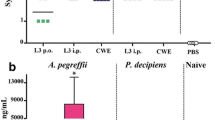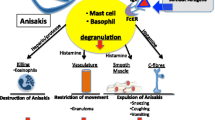Abstract
The third larval stage (L3) of Anisakis simplex (Anisakidae) is one of the zoonotic parasitic nematodes in the musculature and visceral organs of marine fishes belonging to family Moronidae. The consumption of these high-commercial-value fish is widespread in many countries around the Mediterranean Sea including Egypt. The presence of these larvae in fish muscles poses a potential consumer hazard due to the parasite’s ability to cause anisakidosis. Forty-two out of 60 (70 %) of the European seabass Dicentrarchus labrax were found to be naturally infected by L3 of A. simplex in the form of encapsulated juveniles in the fish musculature. Morphological examination of recovered parasites by light and scanning electron microscopy showed that, in general, all specimens examined closely resembled A. simplex (L3). To evaluate the allergenicity of this nematode, white blood cell count; levels of T helper 1 (Th1) [interferon (IFN)-γ and tumor necrosis factor (TNF)-α)], Th2 [IL-4, IL-5, and IL-6], and Th17 [IL-17] related cytokines; total IgE and IgG antibodies; and nitric oxide (NO) were measured in the plasma of Wistar rats sensitized by oral inoculation with fresh, frozen, and heat-treated A. simplex L3 or rats intraperitoneally injected with L3 crude extract. Rats sensitized with fresh and frozen L3 larvae produced significantly higher levels of IFN-γ, IL-5, IL-17, and total IgE as compared to control rats. Heat-treated larvae administration resulted in a significant rise of IFN-γ, TNF-α, IL-5, and total IgE in comparison to control rats. Intraperitoneal sensitizations enhanced release of IFN-γ, TNF-α, and total IgE. Oral sensitization led to a significant production of NO. Thereby, frozen or cooked larval L3 cannot inhibit the release of Th-related cytokines and IgE, which might impact on the overall anti-parasitic immunity.




Similar content being viewed by others
References
Abdel-Ghaffar F, Bashtar AR, Abdel-Gaber R, Morsy K, Mehlhorn H, Al Quraishy S, Mohammed S (2014) Cucullanus egyptae sp. nov. (Nematoda, Cucullanidae) infecting the European eel Anguilla anguilla in Egypt. Morphological and molecular phylogenetic studies. Parasitol Res 113(9):3457–3465
Abdel-Ghaffar F, Abdel-Gaber R, Bashtar AR, Morsy K, Mehlhorn H, Al Quraishy S, Saleh R (2015) Hysterothylacium aduncum (Nematoda, Anisakidae) with a new host record from the common sole Solea solea (Soleidae) and its role as a biological indicator of pollution. Parasitol Res 14:513–522
Abdou NE (2005) Studies on the anisakid nematode juveniles infecting some Red Sea fishes in Egypt. J Zool Invert Parasitol 47:147–160
Anderson RC (2000) Nematode parasites of vertebrates: their development and transmission. CAB, Wallingford
Arthur JR, Margolis L, Whitaker DJ, McDonald TF (1982) A quantitative study of economically important parasites of walleye pollock (Theragra chalcogramma) from British Columbian waters and effects of postmortem handling on their abundance in the musculature. J Fish Red Board Can 39:710–726
Audicana MT, Kennedy MW (2008) Anisakis simplex: from obscure infectious worm to inducer of immune hypersensitivity. Clin Microbiol Rev 21(2):360–379
Audicana M, Fernández de Corres L, Muñoz D, Fernández E, Navarro JA, Del Pozo MD (1995) Recurrent anaphylaxis due to Anisakis simplex parasitizing sea-fish. J Allergy Clin Immunol 96:558–560
Audicana MT, Ansotegui IJ, de Corres LF, Kennedy MW (2002) Anisakis simplex: dangerous–dead and alive? Trends Parasitol 18:20–25
Baeza ML, Conejero L, Higaki Y, Martín E, Pérez C, Infante S, Rubio M, Zubeldia JM (2005) Anisakis simplex allergy: a murine model of anaphylaxis induced by parasitic proteins displays a mixed Th1/Th2 pattern. Clin Exp Immunol 142(3):433–440
Bouree P, Paugam A, Petithory JC (1995) Anisakidosis: report of 25 cases and review of the literature. Comp Immunol Microbiol Infect Dis 18:75–84
Bradford MM (1976) A rapid and sensitive method for the quantitation of microgram quantities of protein utilizing the principle of protein-dye binding. Anal Biochem 72:248–254
Bush AO, Aho JM, Kennedy C (1990) Ecological versus phylogenetic determinants of helminth parasite community richness. Evol Ecol 4:1–20
Caballero ML, Moneo I (2004) Several allergens from Anisakis simplex are highly resistant to heat and pepsin treatments. Parasitol Res 93:248–251
Chai J, Murrell KD, Lymbery AJ (2005) Fish-borne parasitic zoonoses: status and issues. Int J Parasitol 35:1233–1254
Chen Q, Yu HQ, Lun ZR, Chen XG, Song HQ, Lin RQ, Zhu XQ (2008) Specific PCR assays for the identification of common anisakid nematodes with zoonotic potential. Parasitol Res 104:79–84
Cho TH, Park HY, Cho S, Sohn J, Yoon YW, Cho JE, Cho SW (2006) The time-course of biological and immunochemical allergy states induced by Anisakis simplex larvae in rats. Clin Exp Immunol 143:203–208
Costa G, Pontes T, Mattiucci S, Amelio SD (2003) The occurrence and infection dynamics of Anisakis larvae in the black-scabbard fish, Aphanopus carbo, chub mackerel, Scomber japonicas, and Oceanic horse mackerel, Trachurus picturatus from Adeira, Portugal. J Helminthol 77:163–166
Cruz CA, Saraiva VA (2005) Larval anisakids from horse mackerel in Portugal. Helminthologia 42(1):3–7
Dick TA, Choudhury A (1995) Phylum Nematoda. In: Woo PTK (ed) Fish diseases and disorders, volume I protozoan and metazoan infection. Cambridge University Press, Cambridge, pp 415–446
Dorny P, Praet N, Deckers N, Gabriel S (2009) Emerging food-borne parasites. Vet Parasitol 163:196–206
Else KJ, Finkelman FD, Maliszewski CR, Grencis RK (1994) Cytokine mediated regulation of chronic intestinal helminth infection. J Exp Med 179:347–351
Flesch IE, Kaufmann SH (1990) Activation of tuberculostatic macrophage functions by γ-interferon, interleukin-4, and tumor necrosis factor. Infect Immun 58:2675–2677
Flohr C, Quinnell RJ, Britton J (2009) Do helminth parasites protect against atopy 408 and allergic disease? Clin Exp Allergy 39:20–32
Grencis RK (1996) T cell and cytokine basis of host variability in response to intestinal nematode infections. Parasitology 112:S31–S37
Inoue K, Oshima SI, Hirata T, Kimura I (2000) Possibility of anisakid larvae infection in farmed salmon. Fish Sci 66:1049–1052
Kennedy MW, Tierney J, Ye P, McMongle FA, McIntosh A, McLaughlin D, Smith JW (1988) The secreted and stomach antigens of the third stage larvae of Anisakis simplex, and antigenic relationship with Ascaris suum, Ascaris lumbricoides, and Toxocara canis. Mol Biochem Parasit 31:35–46
Kinoshita Y, Fujimoto K, Lee M, Shinohara R, Kobayashi Y, Kawana S, Saeki H (2014) Two cases of allergies due to Anisakis simplex, positive to specific IgE for ani S 12 allergen. Arerugi 63(10):1348–1352
Kirstein F, Horsnell WG, Kuperman DA, Huang X, Erle DJ, Lopata AL (2010) Expression of IL-4 receptor alpha on smooth muscle cells is not necessary for development of experimental allergic asthma. J Allergy Clin Immunol 126:347–354
Klimpel S, Abdel-Ghaffar F, Al-Rasheid KA, Aksu G, Fischer K, Strassen B, Mehlhorn H (2011) The effects of different plant extracts on nematodes. Parasitol Res 108(4):1047–1054
Køie M (2001) Experimental infections of copepods and sticklebacks Gasterosteus aculeatus with small ensheathed and large third stage larvae of Anisakis simplex (Nematoda: Anisakidae). Parasitol Res 87:32–36
Mehlhorn H, Al-Quraishy S, Al-Rasheid KA, Jatzlau A, Abdel-Ghaffar F (2011) Addition of a combination of onion (Allium cepa) and coconut (Cocos nucifera) to food of sheep stops gastrointestinal helminthic infections. Parasitol Res 108(4):1041–1046
Min B (2008) Basophils: what they “can do” versus what they “actually do”. Nat Immunol 9(12):1333–1339
Misko TP, Schilling RJ, Salvemini D, Moore WM, Currie MG (1993) A fluorometric assay for the measurement of nitrite in biological samples. Anal Biochem 214(1):11–16
Moravec F (1994) Parasitic nematodes of freshwater fishes of Europe. Academia and Kluwer Academic Publishers, Prague, p 473
Morsy K, Bashtar AR, Abdel-Ghaffar F, Mehlhorn H, Quraishy SA, Mahdi ME, Al-Ghamdi A, Mostafa N (2012) First record of anisakid juveniles (Nematoda) in the European seabass Dicentrarchus labrax (Family: Moronidae), and their role as bioindicators of heavy metal pollution. Parasitol Res 110(3):1131–1138
Morsy K, Bashtar AR, Abdel-Ghaffar F, Mostafa N (2013) New host and locality records of two nematode parasites Dujardinnascaris mujibii (Heterocheilidae) and Hysterothylacium aduncum (Anisakidae) from the common seabream Pagrus pagrus: a light and scanning electron microscopic study. Parasitol Res 112(2):807–815
Morsy K, Bashtar AR, Mostafa N, El Deeb S, Thabet S (2015) New host records of three juvenile nematodes in Egypt: Anisakis sp. (Type II), Hysterothylacium patagonense (Anisakidae), and Echinocephalus overstreeti (Gnathostomatidae) from the greater lizard fish Saurida undosquamis of the Red Sea. Parasitol Res 114(2):513–522
Mukai K, Matsuoka K, Taya C, Suzuki H, Yokozeki H, Nishioka K, Hirokawa K, Etori M, Yamashita M, Kubota T, Minegishi Y, Yonekawa H, Karasuyama H (2005) Basophils play a critical role in the development of IgE-mediated chronic allergic inflammation independently of T cells and mast cells. Immunology 23(2):191–202
Noguera P, Collins C, Bruno D, Pert C, Turnbull A, McIntosh A, Lester K, Bricknell I, Wallace S, Cook P (2009) Red vent syndrome in wild Atlantic salmon Salmo salar in Scotland is associated with Anisakis simplex sensu stricto (Nematoda: Anisakidae). Dis Aquat Org 87:199–215
Pavanelli WR, Silva JJN (2010) The role of nitric oxide in immune response against Trypanosoma cruzi infection. Open Nitric Oxide J 2:1–6
Petithory JC, Marti B (1988) L’anisakiase en France. Lett l’Infectiologue 2:96
Platt NE (1975) Infestation of cod (Codus morhua L) with larvae of cod worm (Terranova decipiens Krabbe) and herring worm, Anisakis sp. (Nematoda: Ascaridata) in the north Atlantic. J Appl Ecol 12:437–450
Podolska M, Horbowy J (2003) Infection of the Baltic herring (Clupea harengus membras) with Anisakis simplex larvae, 1992–1999: a statistical analysis using generalized linear models. J Mar Sci 60:85–93
Post G (1987) Animal parasites of fishes: textbook of fish health. T.F.H. Publications, Inc. USA, pp. 159–214
Randall DA, Shao Q, Moeng CH (1992) A second order bulk boundary-layer model. J Atmos Sci 49:1903–1923
Rocka A (2004) Nematodes of the Antarctic fishes. Pol Polar Res 25(2):135–152
Shih HH, Jeng MS (2002) H. aduncum (Nematoda: Anisakidae) infecting a herbivorous fish, Siganus fuscescens, off the Taiwanese Coast of the Northwest Pacific. Zool Stud 41(2):208–215
Shih HH, Ku CC, Wang CS (2010) Anisakis simplex (Nematoda: Anisakidae) third-stage larval infections of marine cage cultured cobia, Rachycentron canadum L., in Taiwan. Vet Parasitol 171:277–285
Shimoda K, van Deursen J, Sangster MY (1996) Lack of IL- 4 induced Th2 responses and IgE class switching in mice with disrupted STAT 6 gene. Nature 380:630–633
Smith JW (1984) The abundance of Anisakis simplex L3 in the body-cavity and flesh of marine teleosts. Int J Parasitol 14:491–495
Sugawara Y, Urawa S, Kaeriyama M (2004) Infection of Anisakis simplex (Nematoda: Anisakidae) larvae in chum salmon (Oncorhynchus keta) in the North Pacific Ocean, Bering Sea, and a river of Hokkaido. North Pacific Anadromous Fish Commission Doc 791. Hokkaido Tokai University, Sapporo
Takahashi S, Ishikura H, Kikuchi K (1998) Anisakidosis: global point of view. In: Ishikura H, Aikawa M, Itakura H, Kikuchi K (eds) Host response to international parasitic zoonoses. Springer, Tokyo, pp 109–120
Tsujimura Y, Obata K, Mukai K, Shindou H, Yoshida M, Nishikado H, Kawano Y, Minegishi Y, Shimizu T, Karasuyama H (2008) Basophils play a pivotal role in immunoglobulin-G-mediated but not immunoglobulin-E-mediated systemic anaphylaxis. Immunology 28(4):581–589
Urban JF Jr, Madden KB, Svetic A (1992) The importance of TH2 cytokines in protective immunity to nematodes. Immunol Rev 127:205–220
Van Thiel PH (1962) Anisakiasis. Parasitology 52:16–17
Williams HH, Jones A (1994) Parasitic worms of fish. Taylor & Francis, London
Wink DA, Hines HB, Cheng RY, Switzer CH, Flores-Santana W, Vitek MP, Ridnour LA, Colton CA (2011) Nitric oxide and redox mechanisms in the immune response. J Leukoc Biol 89(6):873–891
Yazdanbakhsh M (1996) IgE, eosinophils and mast cells in helminth infections. Ned Tijdschr Klin Chem 21:213–216
Yazdanbakhsh M, Kremsner PG, van Ree R (2002) Allergy, parasites, and the hygiene hypothesis. Science 296:490
Acknowledgments
The authors extend appreciations to the Faculty of Science, Cairo University, Cairo, Egypt, and to the Deanship of Scientific Research at King Saud University for funding the work through the international research group project IRG14-23.
Author information
Authors and Affiliations
Corresponding author
Rights and permissions
About this article
Cite this article
Abdel-Ghaffar, F., Badr, A.M., Morsy, K. et al. Cytokine signature and antibody-mediated response against fresh and attenuated Anisakis simplex (L3) administration into Wistar rats: implication for anti-allergic reaction. Parasitol Res 114, 2975–2984 (2015). https://doi.org/10.1007/s00436-015-4500-5
Received:
Accepted:
Published:
Issue Date:
DOI: https://doi.org/10.1007/s00436-015-4500-5




